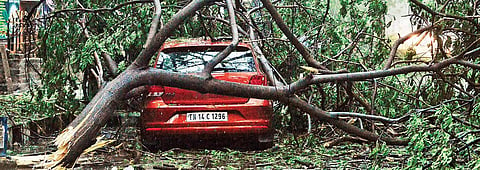

CHENNAI: Learning lessons from cyclone ‘Vardah’, which hit the coasts of Chennai, Kancheepuram and Tiruvallur districts last year, the Tamil Nadu government has devised a comprehensive strategy, with special focus on the fishing community, to face any such challenges during the Northeast monsoon.
The State Disaster Management Authority (SDMA)’s four-pronged strategy with stage-specific mechanism is aimed at mitigating damage and protecting lives.
The key aspects of the strategy are pre-cyclone watch, cyclone alert, cyclone warning and look out. “The four-stage strategy to face natural calamity such as cyclone deals with the developments starting from 72 hours before landfall and lasts up to zero hour. Precautionary measures will be launched once we receive indications for a possible cyclone,” K Satyagopal, Commissioner for revenue administration (CRA) and relief commissioner, told Express.
During Stage I, focus will be on alerting the concerned authorities and agencies, mobilising forces of NDRF and SDRF and first responders along with boats for evacuation and pre-positioning of essential commodities and mobile teams, including snake catchers. These apart, advisories will be sent to railways, airport, transport and highways departments for necessary precaution.
Attention will be paid to logistics and equipment required for attending to emergency situations. Sandbags to plug holes/breaches in water bodies, earth movers and power saws will be kept ready, besides fine tuning the communication equipment during Stage II stretching between 24-48 hours.
According to the CRA, Stage III (between 12-24 hours) focuses on cyclone warning. Evacuation activities would begin during this stage and dissemination of information on the progress of the cyclone and the dos and don’ts will be made extensively to keep the community sensitised to the calamity and its subsequent impact, besides intensifying patrolling on habitations to avert looting.
During look out period, Stage IV, stretching between 0-12 hours, extensive measures, particularly issuing warnings and alerts to the public, will be taken up to avoid damages to life of humans and cattle.
“The crucial aspect during this stage is announcing holidays to schools and colleges to avoid students getting stranded and traffic snarls. Private firms will be advised to provide either leave or permission to work from home. This strategy helped us well in minimising the hardship and casualty during ‘Vardah’ last year,” the official said.
Special focus on fishing community
During cyclone formations, special focus will be on the fishing community as several fishermen ignore warnings and venture into the sea, due to ignorance or audacity. Tamil Nadu has 13 coastal districts, which will be brought under the radar of State Disaster Management Authority (SDMA), district administrations and District Disaster Management Authorities (DDMAs). Satyagopal said, “As and when indications of a cyclone are received, a door-to-door verification of fishermen will be conducted to check their physical presence at the habitations”
Steps will also be taken to secure their boats by tying them at safe points and cattle herded to safe places. As many as 3,277 areas have been classified based on vulnerability in coastal districts
13
Coastal districts in Tamil Nadu
503
Very high vulnerable areas
998
Moderate vulnerable areas
681
High vulnerable areas